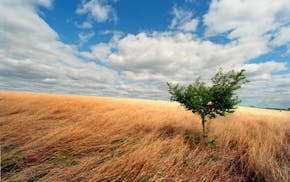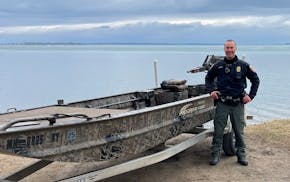Gov. Tim Walz's announcement recently that he wants to make Minnesota the best state in the country to raise kids drew chuckles from various quarters, given Walz's promise in November to Jesse Ventura to legalize weed if Ventura supported the governor in his re-election bid.
That Walz or anyone else seeking office would covet the unserious Ventura's backing for anything, let alone for the governorship of Minnesota, seemed otherworldly at the time.
But when Ventura, the self-described "hunter of men,'' revealed he had heaved his helium-like political weight behind Walz because the governor had assured him that legalizing marijuana would be one of the DFL's first acts in the coming legislative session, and that Ventura would be a guest of honor at the bill signing, well, Minnesotans were comforted that their futures, and particularly those of their children, were safe in Walz's hands.
Unless, of course, those kids want at some point in their lives to swim in a clean river or lake, or perhaps eat a fish caught from those waters.
If so, their recreational interests would align with those of most Minnesotans. Enjoying a refreshing dip in a lake or river has long been a summertime joy in this state, and is an especially welcome distraction for city kids who have few other options for cooling off on hot days.
And fishing? In its percentage of residents who seek bluegills and bass, walleyes and muskies, Minnesota is second only among states to Alaska. In fact, fishing is the most popular participant activity in Minnesota, with the Department of Natural Resources peddling more than 1 million licenses a year.
But a couple decades from now, will kids still be able to swim and fish in Minnesota waters?
Maybe. But maybe not, because by the latest count, Minnesota has nearly 3,000 polluted water bodies, an increase of about 350 since Walz took office.
Worse yet, about half of the lakes and rivers in southern Minnesota are too polluted at certain times of the year for either fishing or swimming.
But maybe today's kids won't grow up to be swimmers or anglers, but instead will be fascinated by the colorful plumage of birds, and their singsong voices and their spring and fall migrations.
Since time immemorial, birds have beguiled people, and Minnesota historically has been among a handful of states that attracts twitchers from throughout the world, sometimes to Felton Prairie, other times to Lost River State Forest, Agassiz National Wildlife Refuge, Hawk Ridge or Sax-Zim Bog.
Birds and other wildlife that call these places home enrich people's lives and speak to their souls.
But losses abound among birds, as well.
These days, for example, hearing a meadowlark's bell-like pluk in Minnesota is a rarity. And bobolinks? Their numbers are down by 60% in Minnesota since the 1970s. Habitat losses are a big reason, particularly in the farmlands, and in the run-up to his 2018 election as governor, Walz promised to gather environmentalists, hunters, birders and farmers to find better ways to manage for wildlife — pollinators in particular — southern Minnesota's 500,000 acres of roadsides.
Most important is that roadside mowing is delayed until at least midsummer, so the more than 40 species of birds and animals that call these places home can finish nesting.
But governors are busy, and oftentimes their days are filled with bartering with ex-governors for political support. Which perhaps explains why, during Walz's first term, nothing good on roadsides happened.
Among Minnesota governors, Walz isn't unique for his generalized indifference — defined here as a lack of leadership — to the state's lands and waters. Dating to statehood, most of his predecessors have honed the practice to a fine art.
It couldn't happen if the state's natural-resource management system weren't rigged in the politicos' favor.
Governors do this by appointing the state's top resource professionals, and then, oftentimes, by making sure the professionals' habitat conservation and other objectives don't run afoul of the ambitions of developers, farm groups and just about anyone else whose bottom lines are tied to utilization of the state's woods, waters, fields and wildlife.
For their part, legislators ensure the politicized outcomes by controlling the purse strings of the resource professionals.
Critical to guaranteeing that the system produces the desired results is that rank-and-file Minnesotans — full of goodwill that they are for the care of the natural world — remain too diffuse politically to match the influence of the resource exploiters.
Until control over the state's resources is wrested from the governor's office and the Legislature, nothing will change.
No one is calling for roadblocks to business or to farming or arguing against the benefits to everyone of "progress.'' Instead, balance is the goal, and an understanding that Minnesota's lands and waters are worth sustaining for future generations.
To their credit, Missourians have developed a better system. They established a citizens council to hire and fire their resource leader, and to set the state's conservation policies.
This could be done in Minnesota but not without something akin to a citizen uprising.
Ten years of browbeating at the Legislature and two Capitol rallies were required to get the 2008 Legacy Amendment on the statewide ballot, and at least that much effort would be required to put Minnesotans, finally, in more direct charge of their state's most valuable assets.
Were that to happen, Minnesota would indeed be the best place to raise kids.
Anderson: Minnesota researcher roamed the Arctic with curious wolves unafraid

Anderson: DNR wants to cut Minnesota walleye limit to 4, but some want the idea thrown back

Anderson: It's time to get politics out of Minnesota conservation



